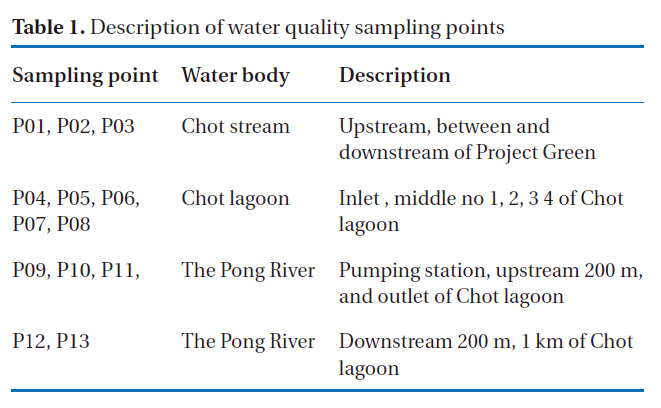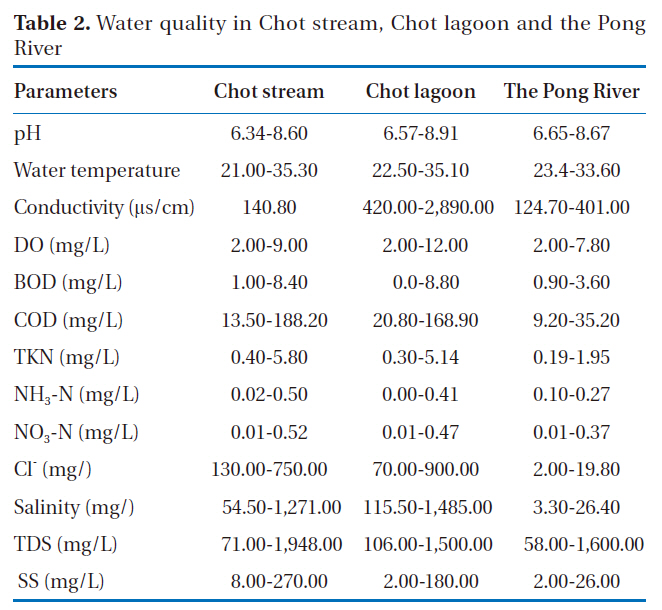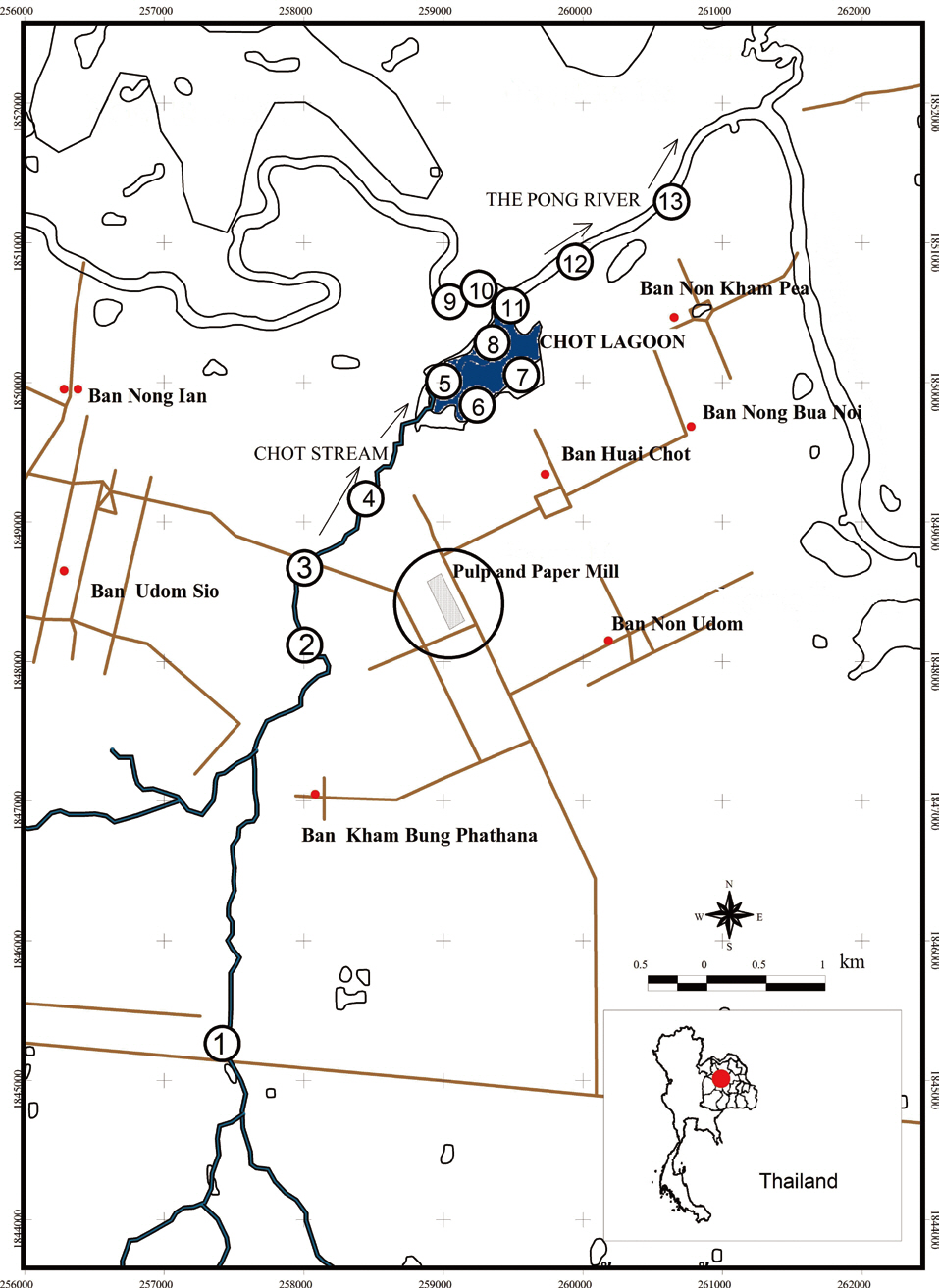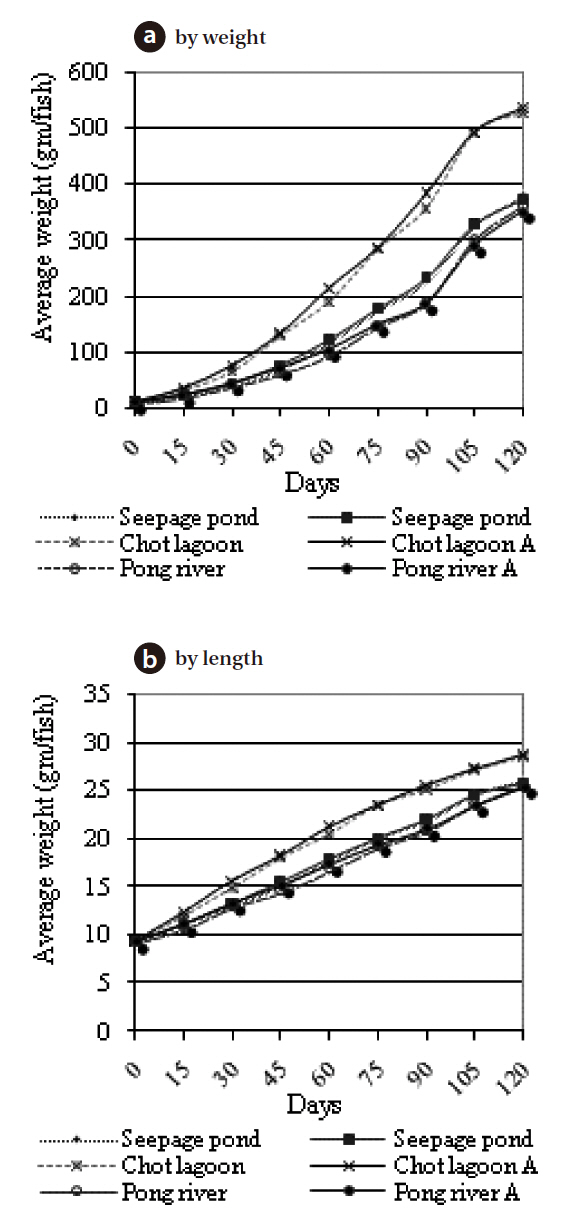



Pulp and paper mill wastewater has been treated by biological treatment, but the secondary effluent still contains high lignin, chemical oxygen demand, color and total dissolved solids. Tertiary treatment by land application, referred to as ‘Project Green,’ has been implemented to treat such high quantities of undesirable matters. The impacts of seepage from Project Green diffusing into receiving streams on the water quality and fish pen aquaculture were studied via the integration of technical and social approaches. The determination of the water quality was performed for 13 sampling stations along the receiving stream, including the Chot stream, Chot lagoon and the Pong River. The water quality was generally at normal levels, with the exception of total dissolved solids. The levels of matter were higher at the Chot stream, but became more diluted at the Chot lagoon and the Pong River, respectively. The social approach was conducted through the voluntary participation of the villagers as research assistants for the fish aquaculture study. Fish could grow at three fish pens within the study sites at the location of Project Green, the Chot lagoon and the Pong River. Fish growth at the Chot lagoon was better at the site of Project Green and the Pong River. The integration of technical and social approaches was a meaningful tool not only for the technical feasibility but in helping to solve the conflict between the community and industry.
The Pong River is the major water resource of Northeastern Region Thailand, and is very important to all the people who live by and are associated with the river. A large industry, Phoenix Pulp and Paper Mill, is situated along the Pong River. Wastewater from the Mill process is directed to a biological treatment plant, including sedimentation, activated sludge and a land treatment system, which incorporates a eucalyptus plantation. This land treatment is specifically named as “Project Green.” It should be noted that the pollution is from a point source to a non-point or diffuse source with Project Green. Seepage from Project Green diffusing to a series of receiving streams would possibly have an impact on the water quality, consequently further impacting the water use and ecosystem. The study of the operation of Project Green revealed that there was a limited land area for handling the effluent loading [1]. Therefore, it is necessary to assess the impact of such effluent diffusion and/or seepage. This study focused on the impact of the effluent/seepage on the fishery (fish pen aquaculture), agriculture and water quality in the receiving water body [2].
This paper presents only the technical approach of the water quality study; the fish pen aquaculture will be described later.
Water quality monitoring was conducted for 13 stations in the series of receiving stream; Chot stream, Chot lagoon and the Pong River (Fig. 1, Table 1), twice a month for about 10 months (March 2007-January 2008). The water quality analyses included pH, temperature, conductivity, dissolved oxygen (DO), biochemical oxygen demand (BOD), chemical oxygen demand (COD), total kjeldhal nitrogen (TKN), ammonia-nitrogen (NH3-N), nitrate (NO3-N), chloride (Cl-), salinity, total dissolved solids (TDS) and suspended solids (SS).
Three sites were potentially influenced by the effluent and/or
[Table 1.] Description of water quality sampling points

Description of water quality sampling points
seepage, including the seepage pond in the project green area, the Chot lagoon, where the effluent seeping to the Chot stream flows to the Chot lagoon, and to the Pong River near the outlet of the Chot lagoon. At each selected location, six pens (3 pens with aerators and 3 pens without aerators) were installed. The aerator was a submersible pump with a pumping rate of 2,000 liter per hour. Based on the existing commercial fish reared by the farmers, Nile Tilapia (
The investigations revealed variable water quality along the length of the receiving water body. However, the water quality had normal levels, with the exception of the mineral contents. Table 2 presents all water quality parameters studied, with some significant parameters, including DO, BOD, TKN and TDS, shown in Figs. 2a-d. The average DO contents in the Chot stream, Chot lagoon and Pong River were 5.5, 6.0 and 4.0 mg/L, respectively, as shown in Fig. 2a. The BOD contents in the Chot stream, Chot lagoon and Pong River were 2.0, 3.0 ad 1.5 mg/L, respectively (Fig. 2b). However, the highest BOD content of about 8.0 mg/L was found in the Chot lagoon and stream, indicating contamination by some organic matter in these stream sections.Similarly, the TKN content was higher in the Chot stream and lagoon, with averages of 1.8 mg/L and about 1.0 mg/L in the Pong River (Fig. 2c). The highest of TKN contents were found to be 5.14-5.83 mg/L in the Chot stream and lagoon. The NH3-N and NO3-N were not significantly different in the Chot stream, lagoon and Pong River, with ranges of 0-0.5 mg/L for NH3-N, and 0.01-0.52 mg/L for NO3-N (Table 2). From the Surface Water Quality Standard, the average concentrations of the above mentioned parameters would represent water quality class 3[3]. The concentrations of the mineral contents, as indicated by the Cl-, TDS, salinity and conductivity shown in Table 2, were higher along the Chot stream downstream of Project Green, lower in the Chot lagoon and much lower in the Pong River (Fig. 2d), which was due to the dilution effect. The TDS contents monitored in the Chot stream and lagoon ranged from 71 to 1,948 mg/L and 120 to 1,500 mg/L, respectively, which could have a moderate impact on irrigation compared to the recommended level, which is lower 500 mg/L [4]. However, the study on rice cultivation indicated no significant impact from the use of water from the Chot lagoon [5].
[Table 2.] Water quality in Chot stream Chot lagoon and the Pong River

Water quality in Chot stream Chot lagoon and the Pong River
3.2. Fish Pen Aquaculture Study
The average weight of the fish reared in the pen in the Chot lagoon, the seepage pond and Pong River were ranged from 528 to 535, 372 to 381 and 360 to 362 gm/fish, respectively. Similarly, the length of the fish was longer for those reared in the Chot lagoon (28.57-28.74 cm) compared to the seepage pond (25.81-26.07 cm) and the Pong River (25.32-25.71 cm). These receiving stream sections enabled fish to be reared, but the Chot lagoon was a better compared to the other two locations. The water quality in terms of the DO contents were monitored both inside and outside of the fish pen, and were found to be sufficient for fish growth, particularly the Chot lagoon due to the greater surface area, allowing better aeration to take. However, no significant difference in fish growth was found between the fish pen with and without aerators (Figs. 3a and b) [6].
An impact on the water quality in terms of increasing the mineral contents due to seepage from Project Green seepage was observed in the Chot stream), which directly received the seepage, but further downstream (the Chot lagoon and the Pong River) no impact was observed. The other water quality parameters were within normal levels, particularly the DO content; therefore, no impact on the fish pen aquaculture was indicated.Fish growth was monitored at three studied sites; the seepage ponds in Project Green, the Chot lagoon and the Pong River. The fish growth was higher at the Chot lagoon site than at the other two sites. Therefore, the utilization of the effluent from Pulp and Paper for aquaculture would be technically feasible.




